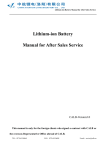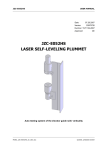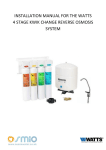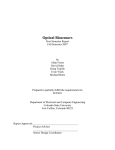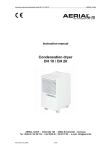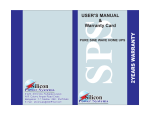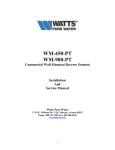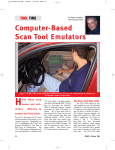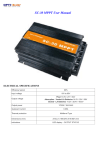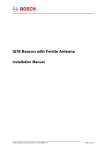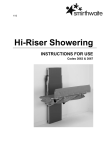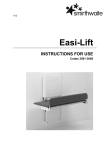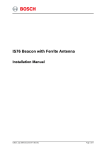Download Lithium-ion Battery After Sales Service Manual
Transcript
Lithium-ion Battery After Sales Service Manual Lithium-ion Battery After Sales Service Manual CALB-Version3.0 This manual only for the foreign clients who signed a contract with CALB or the Representative Office abroad of CALB. A.S TEL:0379-65196060 fax:0379-65196088 E-mail:[email protected] Lithium-ion Battery After Sales Service Manual Contents 1. Matters need attention before battery using……………………1 2. Charging & discharging characteristics …………………………1 3. Installation and maintenance ………………………………………2 3.1 Basic requirements for battery installation………………3 3.2 Basic requirements for battery connection…………………4 3.3 Basic requirements for storage and maintenance …………7 4. Troubleshooting methods………………………………………………7 5. Disclaimer ………………………………………………………………10 It is really appreciated that you choose the Lithium-ion battery made by CALB. Please read this instruction carefully before using the battery. In order to make sure of using correctly, please keep this service manual carefully for future reference. A.S TEL:0379-65196060 fax:0379-65196088 E-mail:[email protected] Lithium-ion Battery After Sales Service Manual 一、 Matters need attention before battery using 1. The battery user shall carefully read the battery using guide and other explanatory materials, familiar with the charging and discharging characteristics, understand the usage of BMS and charging generator before using our products. 2. Dynamic monitor is necessary for OCV of individual cell at any time or condition, charging & discharging test without BMS or PCB is forbidden under any situation in case of any kind of over charge or discharge. 3. Battery safety valve is explosion-free designed for avoiding longtime overcharging, damageable extrusion and accidental short circuit. Screw action is not allowed under any circumstance. 4. New ex-factory cell usually have 60% of SOC, do not long time using the battery before the adjustment of BMS and charger completed in case of over discharge the battery. 5. BMS shall have cell using data storage and fault code record function, the historical data for last week is necessary for analysis the reason of failure. 6. How to recognize the laser encoding of the battery. Bar codes of the battery are 16 digits, including 3 digits of area code, 3 digits of capacity code, 6 digits of production date and 4 digits of serial number. Specific Instructions are as follows. a. Area Code America NSA Europe space+EU Africa AFR A.S TEL:0379-65196060 fax:0379-65196088 E-mail:[email protected] Lithium-ion Battery After Sales Service Manual Asia and Australia Space+AP b. Capacity Code Capacity code is the number of capacity of the battery. For example, the capacity code of 100AH is 100. c. Production Date Manufacturing Department mainly confirmed the date. Same date with a batch of batteries is suggested. Date format year/mouth/day For example, Dec.2nd, 2010, that is production date is 101202. d. Serial Number Based on the amount of batteries, 4 digits in all. Such as the serial number of the 20th battery is 0020. For example, the coding is NSA1801012120001 1st battery Dec.12nd, 2010 180AH America 二、Charging & discharging setting characteristics Charging & discharging characteristics are the following statements except specially description. 1. Individual cell charging constant voltage: 3.6V (CCCV charging model, charging voltage for the period which from CC model to CV model.) 2. Charging voltage for N cells connected into series: N×3.60V (CCCV charging model, charger shall automatic convert to CCCV when individual cell voltage raise up to 3.60V.) 3. Trickling charge current for CCCV model: 0.05C (During CV charging period, charging process shall be regarded as over when charging current fall down to 0.05C.) 4. Cut-off charging voltage for individual cell: 3.90V (Charging maximum charging A.S TEL:0379-65196060 fax:0379-65196088 E-mail:[email protected] Lithium-ion Battery After Sales Service Manual voltage for individual cell, charging current shall be cut-off immediately when individual cell voltage raise up to 3.9V.) 5. Individual cell charging float voltage: 3.40V (Charging voltage for the applications in storage power of photovoltaic energy conversion system, UPS power and automobile auxiliary power.) 6. Float charging voltage for N cells connected into series: N×3.40V. 7. Individual cell discharging alert voltage: 3.0V (dynamic value @ 0.3C )( When OCV of individual cell fall down to 3.1V, the depth of discharge has been over 85%; when OCV of individual cell fall down to 3.0V, the depth of discharge has been over 90%. Strongly recommend shallow charge and discharge the cell, if the BMS find individual cell voltage fall down to 3.0V, cell shall be charged on time.) 8. Individual cell discharging cut-off voltage: 2.50V (dynamic value @ 0.3C)(Minimum discharge voltage is 2.0V @-20℃, when individual cell voltage fall down to 2.0V, output current shall be cut-off immediately, if cell been over discharge seriously, the damage which cause by that is unrecoverable.) 9. Cell temperature parameters(measure the terminal temperature): BMS shall able to boot the cooling fan when cell temperature raise up to 40℃; BMS shall able to decrease the motor power when cell temperature raise up to 50℃; BMS shall able to shut down the motor when cell temperature raise up to 55℃. 10. Standard requirement of charging & discharging is 0.3C 三、Installation and maintenance 1. Basic requirements for battery installation 1.1 Each group of battery must be properly fixed to the battery box which shall be placed on battery pole up mode after clamping. Changing the direction of installation is not recommended, pictures are as follows. A.S TEL:0379-65196060 fax:0379-65196088 E-mail:[email protected] Lithium-ion Battery After Sales Service Manual 1.2 When using the battery modular group fixture provided by our company, make sure to tighten flat mattress and spring mattress on the rod, assemble and tighten the nut completely to ensure the battery pack maintain clamping state during the bumping driving process. The battery users should also obey above principles if they connect up the cells themselves. A.S TEL:0379-65196060 fax:0379-65196088 E-mail:[email protected] Lithium-ion Battery After Sales Service Manual 1.3 The Battery Module in the compartment should keep 30mm-50mm space at the top to facilitate the connection of a battery management system, wiring harness and repair lines also for better heat elimination. 2. Basic requirements for battery connection 2.1 It is necessary to put on insulating gloves in the process of battery connection. A.S TEL:0379-65196060 fax:0379-65196088 E-mail:[email protected] Lithium-ion Battery After Sales Service Manual 2.2 Socket wrench, fixed wrench, screwdriver and other tools have to be make strict insulated treatments. 2.3 Make sure to avoid short-circuit phenomenon, reverse connection and other possible condition. A.S TEL:0379-65196060 fax:0379-65196088 E-mail:[email protected] Lithium-ion Battery After Sales Service Manual 2.4 Before connecting the battery and management systems, battery aluminum pole on the surface need sanding to remove the oxide layer to reduce contact resistance. 2.5 Bolts on battery poles must be tightened so as to avoid osculate resistance increase. 2.6 Battery pole metal is aluminum material, do not use excessive force when tighten the bolts, so as not to strip the screw thread. 3. Basic requirements for storage and maintenance A.S TEL:0379-65196060 fax:0379-65196088 E-mail:[email protected] Lithium-ion Battery After Sales Service Manual 3.1 If temporarily use, the battery should be stored at temperature of 5-40 ℃, dry, clean and well-ventilated warehouse under temporarily using condition. 3.2 Batteries, which in use or inventory, should be excluded from direct sunlight, also should be away from heat sources at a distance of no less than 2m. 3.3 Batteries shall be storage within the warehouse, flat laid with insulated material and marked by obviously. 3.4 Battery inventory shall not be placed upside down or lying. Mechanical shock or stress, cells exposing to heat and rain is strictly prohibited. 3.5 Formulate stock battery voltage tracking table, check inventory battery voltage every two weeks. 3.6 Fully charge and discharge the cells per month @0.3C, and record the result. 四、Troubleshooting methods A.S TEL:0379-65196060 fax:0379-65196088 E-mail:[email protected] Lithium-ion Battery After Sales Service Manual 4.1 The security of repair maintenance operations and construction of high-voltage battery pack need to paid great attention. 4.2 The battery pole is made from aluminum material; please use the screw tap if you accidently damage the bolts because of excessive force using. 4.3 During the charge and discharge process, in particular, high-current charge and discharge the battery, if the BMS detected any certain individual battery voltage fluctuated widely, and markedly different from other batteries, please carefully check. Whether you have tightened the bolt on the terminals, if not, please tighten it. Whether the oxide layer on the surface of the battery's two polarity pole has been wiped off; if not, use sand paper to clean it. Whether the BMS voltage acquisition line is reliable, please correct the fact connection. Whether there are problems of connection across compartment or over length of wire. Large tolerance will be caused by high voltage depreciation. If there is oxide layer between busbar sheets, please replace the busbar. 4.4 Once the battery is accidentally over-discharge, first charge the battery with 0.1C current and discharge the battery with normal situation after the voltage A.S TEL:0379-65196060 fax:0379-65196088 E-mail:[email protected] Lithium-ion Battery After Sales Service Manual came up to 3.20V or higher. If the voltage cannot be restored, please replace it with the backup battery. 4.5 Once you reverse charging the cells, please replace the cells with substitutions. Make sure the new cell gains the same SOC with other cells. 4.6 If you have any other technical problem, welcome to call our Customer Service Department, +86-0379-65196060. 五、Disclaimer CALB shall not undertake any loss, cost which caused by inappropriate use of the products as follows: 6.1 Using and testing batteries without reliable BMS PCB which cause part short-circuit or over discharge. 6.2 Reverse charge the cells which destroy the cells. 6.3 Not effectively control the charging process which over charge the cells. 6.4 Not effectively control the discharging process which over discharge the cells. 6.5 Not select appropriate cable, connector, lug and other electrical components which cause safety issues by over heat. 6.6 Not install high voltage protection component within main loop. Damage the device by damaged and aging of the wire. 6.7 Adopt the connection method which affect the SOC balance of battery modules (exp. Support devices with the power from some of the cells), which cause over discharge of some cells. 6.8 Bad connection between cable lug and bus bar, decrease the life span by over heat which caused by loosen of the bolt. 6.9 Not check and maintain the batteries periodically, not remove the accident potential on time. 6.10 Any other loss because of not following this manual. A.S TEL:0379-65196060 fax:0379-65196088 E-mail:[email protected] Lithium-ion Battery After Sales Service Manual The final explanation rights of the manual reserved by CALB. CALB will edit this document occasionally, modified documents only provide to customers with productions, does not undertake the responsibility of notifying the original customer. All of the user could search for solutions on our website or through technical service email address: [email protected] Attachment 1: Apply for replacing Fill in Battery Quality Issue Feedback Sheet Accept the application Communicate Make sure if need to replace Fill in Aftersale Problem Solving Feedback Sheet N Y Back the unqualified battery Within 10 working days, prepare the cells A.S TEL:0379-65196060 fax:0379-65196088 E-mail:[email protected]













